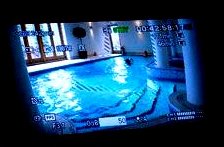- We filmed a scene based on a storyboard which was made by the teachers.
- A story board is a panel or panels on which a sequence of sketches depict the significant changes of action and scene in a planned film, as for a movie, television show, or advertisement.
- A sotryboard is important for preperation and to assure that actors and crew undertsand what needs to be done on the day. It is also to improve the accury of the film.
Below is the storyboard which we used.
- We filmed in the Media classroom where we had a desk, a chair and the view of a door. This location worked for the task as we had a lot of space to use once we had moved the desks to one side of the room.
- We used the desks to film from higher levels so it helped us to vary our camera shots.
- I directed this preliminary task and kept an eye on where the actors stood etc. to make sure that the continuity was correct.
Lighting
- I wasn’t happy with our lighting as it came off too strong and created shadows which seemed unnatural.
- Natural lighting would have looked more appropriate.
- However in certain scenes the shadows emphasized the higher status of one of the characters when one shadow was looming over another.
Filming
- When setting up the camera we; put up the tripod, put the camera on the tripod and used the tripod’s built in spirit level to assure that the camera was level.
- After the camera was correctly placed on the stand we faced the camera toward the white board and adjusted the white balance.
- We then adjusted the exposure which looked appropriate with the lighting
- Before starting the scene we zoomed in on our actress (Tess) and adjusted the focus so that the scene was in focus.
Before we began the recording;
- We would move the camera to the correct position in order to get the correct shot of the actors and to assure that the lighting equipment was not in the shot.
- We framed the shot (assuring there was no head space and plenty of looking space) in order to get the best shots.
What terminology did I learn?
- As the director I learnt many terminologies which are useful to know if I would like to work professionally on set in making a film.

I learnt such terminology as;
- “Stand by”
The director says this to tell everyone to get their equipment ready e.g lighting, cameras.
- “Camera ready” (reply to “standby”)
The camera-man/woman says this to show the director that you are ready to filming .
-“Roll camera”
This is said when actors are in position and everyone is ready to begin filming.
-“Rolling”
This is said by the camera-man/woman when everyone is ready to film.
-“Cut”
The director says this anytime they think is appropriate, usually after the film has ended.
The director says this to let the actors know they can go home and to tell everyone with equipment to pack it away.
Using this terminology for every time we started and stopped recording was very useful as this routine became natural to me.
In Conclusion
From my preliminary task I have learnt;
- To look ahead to the shots that you will be making in order to assure that you can make all your shots without moving your lighting equipment.
- To adjust the lighting until you feel that the level is appropriate for the scene.
- To become accustomed to filming but it also helped me to learn what you must do to prepare yourself before filming.
Final Result
Below is the final result of our Media preliminary task.
Below is the final result of our Media preliminary task.










